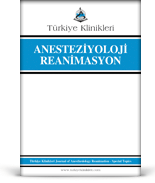Amaç: Kas gevşetici etkilerinin geri döndürülmesinde rölatif olarak yeni bir ajan olan sugammadeks, hızlı etkisi ve rekürarizasyon oranlarındaki azalmayla güvenli kullanımda iyi bir alternatiftir. Bu çalışmada, sugammadeks kullanılan orta ve yaşlı gruptaki hastalarda uyanma ve derlenme hızıyla aynı dönemlerde gelişen yan etkilerin incelenmesi amaçlanmıştır. Gereç ve Yöntemler: Çalışmaya, elektif cerrahide sugammadeks kullanılan, Amerikan Anestezistler Derneği 1-3, 50-64 yaş (Grup 1) ve 65-80 yaş (Grup 2) aralığında, 74 hasta dâhil edildi. Rutin anestezi indüksiyonuyla 0,6 mg/kg roküronyum uygulanan hastalarda dörtlü uyarı [train-of-four (TOF)]: 0 olduğunda endotrakeal entübasyon gerçekleştirildi. Her hasta için kullanılan kas gevşetici dozuna ve anestezistin kararına göre 2-4 mg/kg dozlarda sugammadeks uygulandı. Sugammadeks sonrası ve ekstübasyon sonrası TOF değerleri ve sugammadeks-ekstübasyon süresiyle ekstübasyon-derlenme odasına gidiş süreleri kaydedildi. Derlenme odasında 1, 5, 10 ve 15. dk'larda TOF değeri kaydedildi. Derlenme odasında komplikasyonlar (%92 altında satürasyon düşüklüğü, bradikardi, laringospazm) takip edildi. Bulgular: Grup 1'deki hastaların sugammadeks sonrası TOF değerleri, Grup 2'deki hastaların sugammadeks sonrası TOF değerlerinden anlamlı olarak fazla bulundu. Yine Grup 1'de sugammadeks verildikten sonra ekstübasyona kadar geçen süre anlamlı kısa bulunmuştur. Hastaların ekstübasyon sonrası derlenme odasına gönderilmesine kadar geçen süre Grup 1'de daha kısa bulunmuştur. Komplikasyon açısından sugammadeks sonrası gruplar arasında fark izlenmemiştir. Sonuç: Sonuç olarak, kas gevşetici etkisini geri döndürmede sadece sugammadeks kullanılan bu çalışmada, yaşlı hastalarda orta yaş grubuna göre sugammadeksin ekstübasyon ve derlenme odasına gönderme sürelerinin daha uzun olduğu, ancak iki grupta da belirgin komplikasyon bulunmadığı, bu etkilerin klinik yansımasının zayıf olduğu görülmüştür.
Anahtar Kelimeler: Sugammadeks; nöromusküler depolarize etmeyen ajanlar; nöromusküler monitörizasyon (dörtlü uyarı); anestezi toparlanma dönemi
Objective: Sugammadex is a good alternative for safe use in particularly its rapid action and low rates of recurarization. We aim to examine the difference in awakening, recovery period and the side effects for middle-aged and elderly patients in whom sugammadex was used. Material and Methods: Seventy-four, American Society of Anesthesiologists 1-3 patients aged 50-64 (Group 1) and 65-80 years (Group 2) who were scheduled for elective surgery were included. Tracheal intubation was performed when train-of-four (TOF) was 0 after anesthesia induction with 0.6 mg/kg rocuronium. Sugammadex was administered at 2-4 mg/kg doses, depending on the rocuronium dose used for each patient and the anesthesiologist's assesment. Post-sugammadex and post-extubation TOF values, after-sugammadex to extubation time and extubation to recovery time were recorded. In addition, TOF values were noted at the 1st, 5th, 10th and 15th minutes in the recovery room. Also, SpO2 below 92%, bradycardia and laryngospasm were followed. Results: Post-sugammadex TOF values in Group 1 were found significantly higher than the post-sugammadex TOF values of Group 2. The duration of extubation after sugammadex and the duration to the recovery room after extubation were found significantly shorter in Group1. However, there were no significant difference between the groups regarding complications. Conclusion: In our study, in which only sugammadex was used to reverse the effect of rocuronium, concluded that sugammadex was associated with a prolongation of extubation and referral time to the recovery room in elderly patients compared to middle-aged patients. There were no significant complications in either group, and the clinical reflection of these effects were weak.
Keywords: Sugammadex; neuromuscular nondepolarizing agent; neuromuscular monitoring (train-of-four); anesthesia recovery period
- Viby-Mogensen J, Jørgensen BC, Ording H. Residual curarization in the recovery room. Anesthesiology. 1979;50(6):539-41. [Crossref] [PubMed]
- Cammu G, De Witte J, De Veylder J, Byttebier G, Vandeput D, Foubert L, et al. Postoperative residual paralysis in outpatients versus inpatients. Anesth Analg. 2006;102(2):426-9. [Crossref] [PubMed]
- Carron M, Zarantonello F, Tellaroli P, Ori C. Efficacy and safety of sugammadex compared to neostigmine for reversal of neuromuscular blockade: a meta-analysis of randomized controlled trials. J Clin Anesth. 2016;35:1-12. [Crossref] [PubMed]
- Brueckmann B, Sasaki N, Grobara P, Li MK, Woo T, de Bie J, et al. Effects of sugammadex on incidence of postoperative residual neuromuscular blockade: a randomized, controlled study. Br J Anaesth. 2015;115(5):743-51. [Crossref] [PubMed]
- Schaller SJ, Fink H. Sugammadex as a reversal agent for neuromuscular block: an evidence-based review. Core Evid. 2013;8:57-67. [Crossref] [PubMed] [PMC]
- McDonagh DL, Benedict PE, Kovac AL, Drover DR, Brister NW, Morte JB, et al. Efficacy, safety, and pharmacokinetics of sugammadex for the reversal of rocuronium-induced neuromuscular blockade in elderly patients. Anesthesiology. 2011;114(2):318-29. [Crossref] [PubMed]
- Suzuki T, Kitajima O, Ueda K, Kondo Y, Kato J, Ogawa S. Reversibility of rocuronium-induced profound neuromuscular block with sugammadex in younger and older patients. Br J Anaesth. 2011;106(6):823-6. [Crossref] [PubMed]
- Yoshida F, Suzuki T, Kashiwai A, Furuya T, Konishi J, Ogawa S. Correlation between cardiac output and reversibility of rocuronium-induced moderate neuromuscular block with sugammadex. Acta Anaesthesiol Scand. 2012;56(1):83-7. [Crossref] [PubMed]
- Ledowski T, Szabó-Maák Z, Loh PS, Turlach BA, Yang HS, de Boer HD, et al. Reversal of residual neuromuscular block with neostigmine or sugammadex and postoperative pulmonary complications: a prospective, randomised, double-blind trial in high-risk older patients. Br J Anaesth. 2021;127(2):316-23. [Crossref] [PubMed]
- Ruetzler K, Li K, Chhabada S, Maheshwari K, Chahar P, Khanna S, et al. Sugammadex versus neostigmine for reversal of residual neuromuscular blocks after surgery: a retrospective cohort analysis of postoperative side effects. Anesth Analg. 2022;134(5):1043-53. [Crossref] [PubMed]
- Togioka BM, Yanez D, Aziz MF, Higgins JR, Tekkali P, Treggiari MM. Randomised controlled trial of sugammadex or neostigmine for reversal of neuromuscular block on the incidence of pulmonary complications in older adults undergoing prolonged surgery. Br J Anaesth. 2020;124(5):553-61. [Crossref] [PubMed]







.: İşlem Listesi